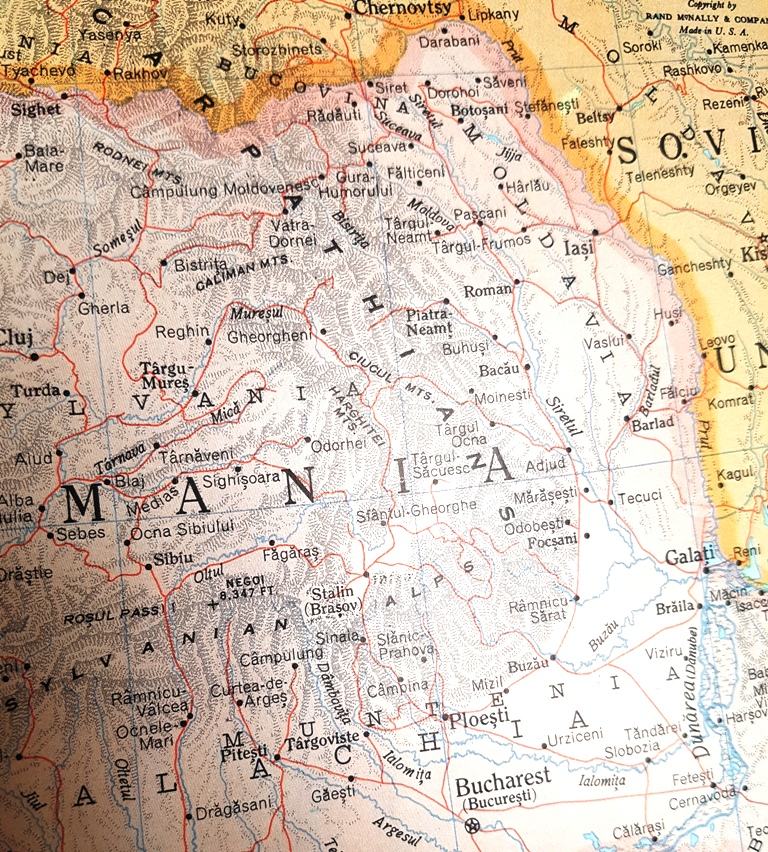Settlements
Settlements are pre-designated villages, towns or cities that originated from maps in the 1952 Collier's Encyclopedia. An example of such a map is shown on the right, originating from Rand McNally & Company.
Contents
The choice of the encyclopedia is based on it being the earliest consistent depiction of the world, making it as close as possible to the time period of Alexis' game world, set in Earth in the year 1650. Since each center shown on the map includes a 1952 population figure, it becomes ideal for estimating the world's population and infrastructure.
Determining Settlement Population
Places are researched to ascertain their date of founding, if such information is available. This information can sometimes be found in the encyclopedia itself, in various other books, or on the internet, especially through Wikipedia. However, these dates often vary between sources and are particularly unreliable online. Since the priority is to make progress rather than ensure pinpoint accuracy, no effort is made to continually cross-check these dates for the most reliable source.
Once a date is determined, it's compared with the 1952 population of the place using the following formula: [1650 - (founding date)] / 4000 * (1952 population).
- For example, let's take the example of the city of Berlin in Germany, which was founded around the year 1237 AD. The calculation goes as follows: 1650 - 1237 = 413; this divided by 4000 equals 0.10325; and when you multiply this by 4,338,756, it gives a 'base' 1650 population of 447,977. While not perfectly accurate, this figure is considered plausible, taking into account the estimates available at the time.
The number "4000" is used as a base number that argues most of the world's cities have been founded since the year 2350 BCE. This isn't always the case, but it's a reasonable guideline.
Disasters
If, over the years since a city's founding, it has suffered historical plundering or been affected by a plague, the calculated population is reduced by 10% for each occurrence of such events. Likewise, if a city has been destroyed or abandoned and then subsequently rebuilt, the total population is reduced by 50% for each such occurrence. In the case of Berlin, which was devastated during the Thirty Years' War, half of its population is removed due to this event. This results in a game total population for Berlin of 223,988.
Founding Date Issues
If a place is described as being founded later than 1650, it is considered not to exist in the game world. For instance, the city of Bournemouth in England, which was founded in 1810, would not be part of the game world.
If a place lacks a specific founding date but there is substantial evidence to suggest its existence, a unique approach is taken. The average of known founding dates within that province is calculated, and this average number is then subtracted from 1650. The result is divided by 36. Then 6d6 are rolled, with each pip multiplied by the product produced by dividing by 36; this final total is subtracted from 1650.
- For example, For example, if the places in a given province have an average founding date of 800 BC, the calculation proceeds as follows: 1650 - 800 = 850; this result is divided by 36, yielding 23.611. When rolling six six-sided dice (6d6) and getting a total of 13, you multiply 13 by 23.611, resulting in 307. Finally, subtracting 307 from 1650 gives the estimated founding year of the place, which in this case is 1343.
Provincial Population
With a founding date established for each place within a province (a general term for all political subdivisions), it is now possible to calculate the population of that province.
| Place Name | 1952 population |
Founding Date |
Game Population |
|---|---|---|---|
| Dorchester | 18,820 | 864 | 1,722 |
| Poole | 80,600 | 760 | 17,934 |
| Weymouth | 35,550 | 1150 | 3,999 |
| Bournemouth | 139,560 | - | - |
| Totals | 266,530 | - | 23,655 |
Using Viscounty of Dorsetshire in southern England, where Bournemouth doesn't exist in the game world, the final population totals have been adjusted due to plague and plundering. Dorchester has experienced such events twice (x0.81), and Weymouth once (x0.9). The combined population of all four cities, including the one that doesn't exist in the game world, is 266,530. Interestingly, this population figure is very close to the 1952 population for all of Dorsetshire, which is 268,480. It appears that most of the population in the shire resided in these four places. However, it's possible that this discrepancy could be attributed to different census dates or that the populations for each center include their surrounding areas.
We include Bournemouth because the absence of the city also affects the 1650 population. So we take the total population of all cities as they are in 1650, divide that by what their population was in 1952, and multiply that by the 1952 population. End total population for all of Dorsetshire: 23,828.
This number is then used to calculate infrastructure.
Effect of Settlements
Because settlements exist prior to mapmaking and infrastructure calculation, they are considered "special" from infrastructure-generated villages or towns. They appear as a larger black dot on game maps, rather than as a smaller brown dot. Each settlement in a 6-mile hex grants a bonus of +1 coin, +1 bread and +1 hammers to that hex. Settlements also have special rules related to hammers that allow for additional special facilities.
See Also,
List of Kingdoms
List of Provinces
List of Settlements
